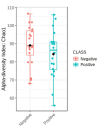Characterization of rumen microbiome and immune genes expression of crossbred beef steers with divergent residual feed intake phenotypes
- PMID: 38443809
- PMCID: PMC10913640
- DOI: 10.1186/s12864-024-10150-3
Characterization of rumen microbiome and immune genes expression of crossbred beef steers with divergent residual feed intake phenotypes
Abstract
We investigated whole blood and hepatic mRNA expressions of immune genes and rumen microbiome of crossbred beef steers with divergent residual feed intake phenotype to identify relevant biological processes underpinning feed efficiency in beef cattle. Low-RFI beef steers (n = 20; RFI = - 1.83 kg/d) and high-RFI beef steers (n = 20; RFI = + 2.12 kg/d) were identified from a group of 108 growing crossbred beef steers (average BW = 282 ± 30.4 kg) fed a high-forage total mixed ration after a 70-d performance testing period. At the end of the 70-d testing period, liver biopsies and blood samples were collected for total RNA extraction and cDNA synthesis. Rumen fluid samples were also collected for analysis of the rumen microbial community. The mRNA expression of 84 genes related to innate and adaptive immunity was analyzed using pathway-focused PCR-based arrays. Differentially expressed genes were determined using P-value ≤ 0.05 and fold change (FC) ≥ 1.5 (in whole blood) or ≥ 2.0 (in the liver). Gene ontology analysis of the differentially expressed genes revealed that pathways related to pattern recognition receptor activity, positive regulation of phagocytosis, positive regulation of vitamin metabolic process, vascular endothelial growth factor production, positive regulation of epithelial tube formation and T-helper cell differentiation were significantly enriched (FDR < 0.05) in low-RFI steers. In the rumen, the relative abundance of PeH15, Arthrobacter, Moryella, Weissella, and Muribaculaceae was enriched in low-RFI steers, while Methanobrevibacter, Bacteroidales_BS11_gut_group, Bacteroides and Clostridium_sensu_stricto_1 were reduced. In conclusion, our study found that low-RFI beef steers exhibit increased mRNA expression of genes related to immune cell functions in whole blood and liver tissues, specifically those involved in pathogen recognition and phagocytosis regulation. Additionally, these low-RFI steers showed differences in the relative abundance of some microbial taxa which may partially account for their improved feed efficiency compared to high-RFI steers.
Keywords: Immunity; RFI; Rumen microbiota.
© 2024. The Author(s).
Conflict of interest statement
The authors declare no competing interests.
Figures





Similar articles
-
Effects of rumen-bypass protein supplement on growth performance, hepatic mitochondrial protein complexes, and hepatic immune gene expression of beef steers with divergent residual feed intake.PLoS One. 2024 Jul 3;19(7):e0293718. doi: 10.1371/journal.pone.0293718. eCollection 2024. PLoS One. 2024. PMID: 38959213 Free PMC article.
-
The differential plasma and ruminal metabolic pathways and ruminal bacterial taxa associated with divergent residual body weight gain phenotype in crossbred beef steers.Transl Anim Sci. 2023 May 23;7(1):txad054. doi: 10.1093/tas/txad054. eCollection 2023 Jan. Transl Anim Sci. 2023. PMID: 37435477 Free PMC article.
-
Transcriptome profiling of the rumen epithelium of beef cattle differing in residual feed intake.BMC Genomics. 2016 Aug 9;17:592. doi: 10.1186/s12864-016-2935-4. BMC Genomics. 2016. PMID: 27506548 Free PMC article.
-
Review: Biological determinants of between-animal variation in feed efficiency of growing beef cattle.Animal. 2018 Dec;12(s2):s321-s335. doi: 10.1017/S1751731118001489. Epub 2018 Aug 24. Animal. 2018. PMID: 30139392 Review.
-
Exploring Biological Impacts of Prenatal Nutrition and Selection for Residual Feed Intake on Beef Cattle Using Omics Technologies: A Review.Front Genet. 2021 Nov 1;12:720268. doi: 10.3389/fgene.2021.720268. eCollection 2021. Front Genet. 2021. PMID: 34790219 Free PMC article. Review.
Cited by
-
Effects of rumen-bypass protein supplement on growth performance, hepatic mitochondrial protein complexes, and hepatic immune gene expression of beef steers with divergent residual feed intake.PLoS One. 2024 Jul 3;19(7):e0293718. doi: 10.1371/journal.pone.0293718. eCollection 2024. PLoS One. 2024. PMID: 38959213 Free PMC article.
-
Selection signatures associated with adaptation in South African Drakensberger, Nguni, and Tuli beef breeds.Trop Anim Health Prod. 2024 Dec 27;57(1):13. doi: 10.1007/s11250-024-04265-8. Trop Anim Health Prod. 2024. PMID: 39729174 Free PMC article.
References
-
- Zhou X, Zhang Y, He L, Wan D, Liu G, Wu X, Yin Y. Serine prevents LPS-induced intestinal inflammation and barrier damage via p53-dependent glutathione synthesis and AMPK activation. J Funct Foods. 2017;39:225–32. doi: 10.1016/j.jff.2017.10.026. - DOI
-
- Huws SA, Creevey CJ, Oyama LB, Mizrahi I, Denman SE, Popova M, Muñoz-Tamayo R, Forano E, Waters SM, Hess M, Tapio I. Addressing global ruminant agricultural challenges through understanding the rumen microbiome: past, present, and future. Front Microbiol. 2018;9:2161. doi: 10.3389/fmicb.2018.02161. - DOI - PMC - PubMed
MeSH terms
Substances
Grants and funding
LinkOut - more resources
Full Text Sources

